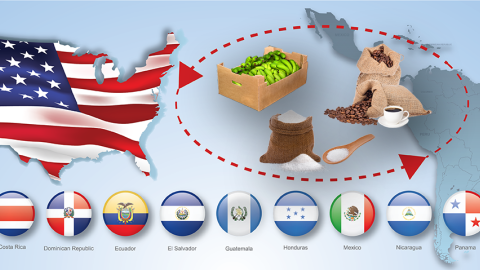This page provides information on:
Global economic conditions drive demand for food and agricultural products, providing the foundation for U.S. agricultural trade. Therefore, the composition and pattern of U.S. agricultural exports and imports shift to reflect changes in trade policies, world population and income, and economic growth. Other factors affecting U.S. agricultural trade include global supplies and prices, changes in exchange rates, and government support for agriculture. For an overview of U.S. agricultural trade, see U.S Agricultural Trade at a Glance.
USDA, Economic Research Service (ERS) provides a range of data products and reports covering U.S. agricultural trade and factors affecting trade flows.
Periodic, Scheduled Outputs
- Foreign Agricultural Trade of the United States (FATUS), a USDA aggregation of data that provide information on U.S. agricultural exports and imports, volume, and value by country and by commodity. Updated monthly or annually.
- The Outlook for U.S. Agricultural Trade forecasts U.S. agricultural exports and imports for the upcoming fiscal year, by country and sector.
- State Agricultural Trade Data include the annually updated State Exports, Cash Receipts Estimates calendar year data set which provides the value of exports by State and commodity, and the quarterly updated State Trade by Country of Origin and Destination fiscal quarter data set which provides the top five U.S. agricultural import and export commodities and the top countries buying or selling those commodities, by State.
- Agricultural Trade Multipliers provide estimates of employment and/or output effects of trade in farm and food products on the U.S. economy. These effects, when expressed as multipliers, reflect the amount of economic activity and/or jobs generated by agricultural exports.
- USDA Agricultural Projections, released in February each year and provide USDA's 10-year projections for the food and agriculture sector including expected U.S. agricultural trade by commodity group.
- U.S. Export Share of Production, Import Share of Consumption (2008-2022) data include the share of U.S. agricultural production, by value, sold outside the country, and the share of imports in total domestic food consumption by value.
- U.S. Food Imports, a dataset that provides import values of edible products (food and beverages) entering U.S. ports and their origin of shipment. Food and beverage import values are compiled by calendar year into food groups corresponding to major commodities or level of processing.
Selected ERS Reports Relating to U.S. Agricultural Trade
In addition to the Outlook report and data products, USDA, ERS produces reports analyzing trade in a particular country or region and key factors affecting trade flows.
Selected USDA, ERS reports relating to U.S. agricultural trade include:
-
The Economic Impacts of Retaliatory Tariffs on U.S. Agriculture
In 2018, the United States imposed Section 232 tariffs on steel and aluminum imports from major trading partners and separately Section 301 tariffs on a broad range of imports from China. In response to these actions, six trading partners—Canada, China, the European Union, India, Mexico, and Turkey—responded with retaliatory tariffs on a range of U.S. agricultural exports, including agricultural and food products. The agricultural products targeted for retaliation were valued at $30.4 billion in 2017, with individual product lines experiencing tariff increases ranging from 2 to 140 percent. This report provides a detailed look at the impact of retaliatory tariffs by State and commodity and estimates the direct export losses associated with the trade conflict. (ERR-304, January 2022)
-
This report explores the performance of U.S. agricultural exports to Colombia over the past decade (2009–19), examining the top 10 exports and 5 additional exports that are among the fastest growing. (AES-118-01, December 2021)
-
Potential Wheat Demand in China: Applicants for Import Quota
This report examines lists of applicants for wheat tariff-rate quota (TRQ) for the years 2015 to 2021 to characterize the potential demand for imported wheat in China. More than 900 companies in China applied for quota from 2015 to 2021, and 171 applied 7 years in a row. (ERR-295, August 2021)
-
Economic Crises and U.S. Agricultural Exports
An examination of past economic crises and a simulation exercise of the effects of possible future crises show that such shocks can reduce U.S. agricultural exports considerably, especially if a crisis hits a number of countries simultaneously. (ERR-282, April 2021)
-
Reforming Market Access in Agricultural Trade: Tariff Removal and the Trade Facilitation Agreement
ERS analyzes two potential scenarios for reforming global agricultural trade—removing all tariffs or eliminating trade costs through the Trade Facilitation Agreement—and compares their effects on trade, production, prices, and social welfare. (ERR-280, April 2021)
-
China's Refusals of Food Imports
Compliance with China’s food standards and regulations can be a challenge for exporters aspiring to sell to that country’s growing market. Refusals of imports fluctuate from year to year, peaking in 2007 and 2017 and dropping to their lowest-ever totals in 2018–19. (ERR-286, March 2021)
-
Agricultural Market Access Under Tariff-Rate Quotas
ERS surveys the first 20 years of World Trade Organization members’ tariff-rate quotas (TRQs) for agricultural products, providing data for an analysis of how TRQ market access for agricultural products has evolved from 1995 to 2015 and the extent to which TRQs are fulfilling their goal of increasing that access. (ERR-279, January 2021)



